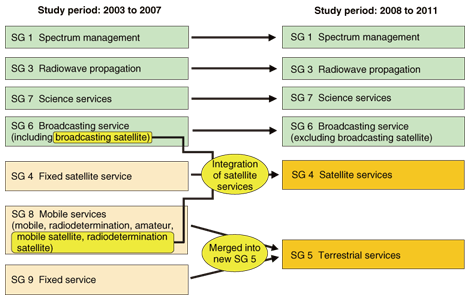 |
|||||||||
|
|
|||||||||
|
Global Standardization Activities Vol. 6, No. 6, pp. 36–38, June 2008. https://doi.org/10.53829/ntr200806gls Report on ITU-R Radiocommunication Assembly 2007 and World Radiocommunication Conference 2007AbstractThe Radiocommunication Assembly 2007 (RA-07) and World Radiocommunication Conference 2007 (WRC-07) of the Radiocommunication Sector of the International Telecommunication Union (ITU-R) were held in October and November 2007 in Geneva, Switzerland. This article is a summary report on these two meetings.
1. Radiocommunication Assembly 2007 (RA-07)The Radiocommunication Assembly (RA) is an international meeting held before the World Radiocommunication Conference (WRC) to approve draft Recommendations prepared by ITU-R Study Groups (SGs), evaluate the activities of SGs, and discuss the structure and Questions of SGs for the next study period. RA-07 was held on October 15–19, 2007, at the International Conference Centre Geneva (CICG) in Switzerland and attended by approximately 500 participants from 98 member states and 12 international organizations. From the NTT Group, NTT and NTT DoCoMo sent a total of 8 participants. 1.1 Changes in SG structureDuring the last study period (2003 to 2007), seven SGs conducted studies on radiocommunication, as shown on the left of Fig. 1. Prior to RA-07, informal meetings were held and they discussed the restructuring of SGs in terms of the efficacy of SGs activities and technical integration between mobile and fixed radiocommunication services. Taking these discussions into account, RA-07 considered the restructuring of SGs and drew the following conclusions (Fig. 1, right):
In addition, the Chair and Vice-chair of each SG were selected. Akira Hashimoto (NTT DoCoMo), Muneo Abe (KDDI), and Yukihiro Nishida (NHK) were selected as Chairman of SG 5, Vice-chairman of SG 4, and Vice-chairman of SG 6, respectively. 1.2 Approval of draft RecommendationsRA-07 considered the draft Recommendations prepared by SGs. It approved six (one new and five revised) draft Recommendations, including the revision of Recommendation ITU-R M.1457 (with the inclusion of Mobile WiMAX (ITU-R name: IMT-2000 OFDMA TDD WMAN)) as the sixth radio interface for IMT-2000 (International Mobile Telecommunications-2000), and rejected three recommendations. 1.3 Approval of ITU-R ResolutionsRA-07 reviewed ITU-R Resolutions, which decide various matters concerning ITU-R activities. It approved 35 (5 new, 18 revised, and 12 maintained) ITU-R Resolutions, including a new Resolution that defines the terminology of systems beyond IMT-2000 as IMT-Advanced and the terminology of IMT-2000 and IMT-Advanced together as IMT, and rejected six resolutions. 1.4 Approval of QuestionsRA-07 approved approximately 330 Questions on radiocommunication technology needed for advanced information networks including Questions on frequency sharing between different services and Questions on IMT-Advanced standardization. 2. World Radiocommunication Conference 2007 (WRC-07)The World Radiocommunication Conference (WRC) is an international meeting that is normally held every three or four years to revise Radio Regulations such as those for frequency allocation for new radiocommunication systems and for international procedures needed for using radio waves. WRC-07, which began the week after RA-07, was held for a period of four weeks from 22 October to 16 November 2007. It was attended by approximately 2800 participants from 164 member states. From the NTT Group, NTT and NTT DoCoMo sent a total of 13 participants. WRC-07 discussed 28 agenda items including the following ones:
2.1 Frequency-related matters for the future development of IMT (IMT-2000 and IMT-Advanced)The following frequency ranges were identified for IMT (IMT-2000 and IMT-Advanced).
Among these frequency ranges, each Administration will select suitable ones for the development of IMT. Japan is planning to use ranges 1 and (part of) 3 for IMT [1]. IMT-Advanced is expected to provide services at 100 Mbit/s for high mobility and 1 Gbit/s for low mobility from 2010, and IMT-Advanced standardization activities will be undertaken by ITU-R and other organizations from now on. 2.2 Technical, operational, and regulatory provisions for frequency sharing in the 2.5-GHz band between satellite services and terrestrial servicesThe 2.5-GHz band (2500–2690 MHz) was identified by WRC-2000 for IMT-2000, and there are great expectations at the international level for its use for terrestrial mobile communication systems. On the other hand, in Japan and several other countries, the 2.5-GHz band is used for satellite services such as mobile satellite services. Therefore, WRC-07 discussed conditions for frequency sharing between satellite and terrestrial services. It concluded that priority should be given to terrestrial mobile service and that strict restrictions should be imposed on the use of satellite services in terms of the power flux density from satellites; however, an exception was made for Japan's mobile satellite service (provided by NTT DoCoMo) because it is a vital system used for emergency communications. 2.3 Regulatory measures regarding the protection of the Earth exploration-satellite service from unwanted emissions of active services such as mobile serviceWRC-07 discussed the restrictions to be imposed on unwanted emissions of active services such as mobile service in order to protect the Earth exploration-satellite service. Strict restrictions were proposed on unwanted emissions from active services in the 1.4-GHz band, which is used for mobile phones in Japan. The final result, however, was that recommended values for unwanted emission limits should be determined on a non-mandatory basis. 2.4 Agenda for World Radiocommunication Conference 2011 (WRC-11)For WRC-11, 33 agenda items were decided, including the following ones:
3. Future activities of ITU-RThere is an increasing need in the market for radio systems, especially for mobile communication applications, and all nations are actively conducting studies on frequency-related matters. The NTT Group will continue its proactive efforts to promote ITU-R activities. Reference
|
|||||||||











